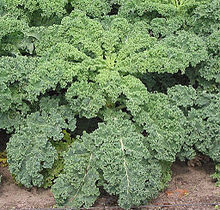species of vegetable, form of cabbage with green or purple leaves From Wikipedia, the free encyclopedia
Kale is a vegetable with green or purple leaves. It is also called borecole. It is in the group of vegetables called Brassica oleracea or wild cabbage. It is cruciferous because of the shape of its flowers.[1]
| Kale | |
|---|---|
 Curly kale | |
| Species | Brassica oleracea |
| Cultivar group | Acephala Group |
| Origin | Unknown, before the Middle Ages |
| Cultivar group members | Many, and some are known by other names. |
A plant that would have been first cultivated in the Mediterranean area, it was called in these times cabbage well before the well rounded variety existed. Kale was a significant crop in Roman times; it became a basic staple for peasants in the Middle Ages and it was bought to the United States by the English in the 17th century.[1]
Kale is one of the most resistant from the cabbage family; it can support temperatures as low as -15 °C but it doesn’t sustain high temperatures. Since it is resistant to cold temperatures and grows easily, kale was an appreciated winter vegetable, especially in Scotland, Germany, Holland and Scandinavia. Today, it is eaten the world over.[1]
Kale has large stringy leaves, very curly, with a well-marked flavor. Their color varies from pale green to dark green, sometimes to blue-tinted green. The leaves are not well rounded, a characteristic expressed by the Latin word which describes this variety of cabbage « acephala » and which means « without head ». The leaves surmount a fine whitish and very fibrous stem, it can measure from 30 to 40 cm. Kale is so decorative that ornamental varieties were developed.[1]
| Nutrient | % Daily Value | World Healthiest Foods Rating |
|---|---|---|
| Vitamin K | 1327.6% | excellent |
| Vitamin A | 354.1% | excellent |
| Vitamin C | 88.8% | excellent |
| Manganese | 27% | excellent |
| Fiber | 10.4% | very good |
| Copper | 10% | very good |
| Tryptophan | 9.3% | very good |
| Calcium | 9.3% | very good |
| Vitamin B6 | 9% | very good |
| Potassium | 8.4% | very good |
| Iron | 6.5% | good |
| Magnesium | 5.8% | good |
| Vitamin E | 5.5% | good |
| Omega 3 fats | 5.4% | good |
| Vitamin B2 | 5.2% | good |
| Protein | 4.9% | good |
| Vitamin B1 | 4.6% | good |
| Folate | 4.2% | good |
| Phosphorus | 3.6% | good |
| Vitamin B3 | 3.2% | good |
| Calories(36) | 2% |
Kale is an excellent source of vitamin K, C, A and manganese; it is a very good source of fiber, copper, tryptophan, calcium, vitamin B6 and potassium. Kale is a good source of iron, magnesium, vitamin E, omega 3 fats, vitamin B2, protein, vitamin B1, folate, phosphorus and vitamin B3.[2]
Kale is rarely eaten raw. We can add it sparingly to salads. It transmits its well-marked taste to soups and stews. You can blanch it to attenuate its flavour. Kale is delicious coated with sauce, sprinkled with cheese or in purée (alone or with mashed potatoes).[3]
Choose kale with firm leaves, well colored and relatively small, without stain or mold.[3] One cup cooked makes 130 grams. Cut the leaves around the stem, cut the core, separate each leaf. Wash well with running water or with vinegary water to remove dirt and bugs that could remain. We cook kale in water or we steam it from 20 to 30 min, braised in a slow cooker, stuffed or sautéed in a wok.[1]
Put the kale leaves very tight rather than loose in refrigerator without washing it, inside a perforated plastic bag. It can be kept in this way from five to ten days, but it is more flavorful and less bitter when it is eaten rapidly. Kale can be frozen after having been blanched two to three minutes, until the leaves soften a bit.[1]
Seamless Wikipedia browsing. On steroids.
Every time you click a link to Wikipedia, Wiktionary or Wikiquote in your browser's search results, it will show the modern Wikiwand interface.
Wikiwand extension is a five stars, simple, with minimum permission required to keep your browsing private, safe and transparent.